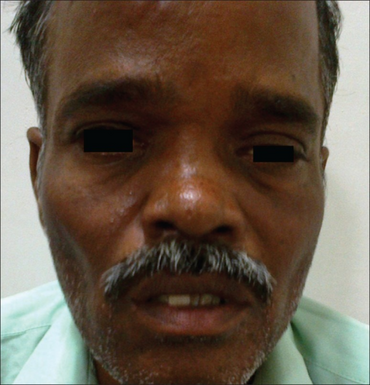Sclerosteosis
| Sclerosteosis | |
|---|---|
 | |
| Coarse facial features with left facial palsy | |
| Frequency | Lua error in Module:PrevalenceData at line 5: attempt to index field 'wikibase' (a nil value). |
Sclerosteosis is an autosomal recessive disorder characterized by bone overgrowth. It was first described in 1958[1][2] but given the current name in 1967.[3] Excessive bone formation is most prominent in the skull, mandible and tubular bones.[1] It can cause facial distortion and syndactyly.[1] Increased intracranial pressure can cause sudden death in patients.[1] It is a rare disorder that is most prominent in the Afrikaner population in South Africa (40 patients), but there have also been cases of American and Brazilian families.[1]
Signs and symptoms
The clinical presentation of an individual with this condition is as follows:[4]
- Optic atrophy
- Webbed 2nd-3rd fingers
- Nasal abnormality
- Curved distal phalanges of hand
- Diaphyseal thickening
- Increased bone density
- Tall stature
Cause
Sclerosteosis is caused by mutations in the gene that encode for the sclerostin protein. The sclerostin protein is necessary in inhibiting canonical wnt signalling. Wnt signalling results in increased osteoblast activity and RANKL synthesis, sclerostine therefore increases boneformation by indirectly inhibiting RANKL synthesis and thus osteoclast activitation.
Diagnosis
The diagnosis of this condition, Sclerosteosis, can be done via:[4]
- Medical exam
- Medical history
- Lab test
- Genetic test
Treatment
There is no current treatment for Sclerosteosis. Management is done to relieve symptoms and preventing complications.[5]
References
- ↑ 1.0 1.1 1.2 1.3 1.4 Balemans W, Ebeling M, Patel N, Van Hul E, Olson P, Dioszegi M, Lacza C, Wuyts W, Van Den Ende J, Willems P, Paes-Alves AF, Hill S, Bueno M, Ramos FJ, Tacconi P, Dikkers FG, Stratakis C, Lindpaintner K, Vickery B, Foernzler D, Van Hul W (Mar 2001). "Increased bone density in sclerosteosis is due to the deficiency of a novel secreted protein (SOST)". Human Molecular Genetics. 10 (5): 537–43. doi:10.1093/hmg/10.5.537. PMID 11181578.
- ↑ Truswell AS (May 1958). "Osteopetrosis with syndactyly; a morphological variant of Albers-Schönberg's disease". The Journal of Bone and Joint Surgery. British Volume. 40-B (2): 209–18. PMID 13539104.
- ↑ Balemans W, Patel N, Ebeling M, Van Hul E, Wuyts W, Lacza C, Dioszegi M, Dikkers FG, Hildering P, Willems PJ, Verheij JB, Lindpaintner K, Vickery B, Foernzler D, Van Hul W (Feb 2002). "Identification of a 52 kb deletion downstream of the SOST gene in patients with van Buchem disease". Journal of Medical Genetics. 39 (2): 91–7. doi:10.1136/jmg.39.2.91. PMC 1735035. PMID 11836356.
- ↑ 4.0 4.1 "Sclerosteosis | Genetic and Rare Diseases Information Center (GARD) – an NCATS Program". rarediseases.info.nih.gov. Archived from the original on 18 March 2021. Retrieved 6 January 2022.
- ↑ Appelman-Dijkstra, Natasha; Van Lierop, Antoon; Papapoulos, Socrates (1993). "SOST-Related Sclerosing Bone Dysplasias". GeneReviews®. University of Washington, Seattle. Archived from the original on 27 November 2020. Retrieved 6 January 2022.
External links
- These Superhumans Are Real and Their DNA Could Be Worth Billions Archived 2021-03-09 at the Wayback Machine
- Sclerostin Inhibition in the Management of Osteoporosis Archived 2022-01-11 at the Wayback Machine
- Effect of bone thickening on the skull area: need of skull removal Archived 2022-01-02 at the Wayback Machine